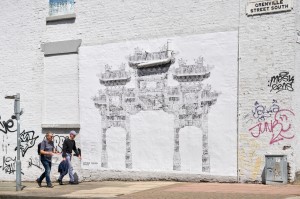Palestinian Storytelling, World-Building, and Time Travel: Our Preview of Liverpool Arab Arts Festival (LAAF) 2025

The latest Liverpool Arab Arts Festival arrives this Friday. Here, Mike Pinnington takes a trip through some of 2025′s not-to-be-missed highlights…
Just like that, we’re well into July, and Liverpool’s cultural calendar continues to unfold correspondingly, with Friday’s launch of LAAF 2025. Across performance, art, music, community, literature and workshops, this year’s iteration of the UK’s longest-running annual Arab arts and culture festival addresses the thorny topic of nostalgia.
Should you have dipped a toe – or dived enthusiastically – into the Biennial (which opened last month), you’ll likely have visited its Walker Art Gallery offering. There, the catalogue tells us, we’ll find ‘densely material works which interweave practices exploring personal and colonial legacies within an ornate building and national collection founded on the merchant wealth of the city’.
Included in its display is Nour Bishouty (whose heritage encompasses Lebanon, Jordan, Palestine and Canada), one of a trio of artists forming this year’s LAAF visual arts strand. Bishouty’s constellation of works, collectively titled Nothing is lost except nothing at all except what is not had, has, at its centre, Al-Wadi (top), an artwork depicting a Bedouin tribe in Jordan.
Made by the artist’s father, Ghassan, it is the departure point for a wider, thoughtful installation, which includes carvings of animals, a beautiful photo-collage, and textiles – all of which speak to lives lived in the shadow of cultural and practical erasure. Nothing is lost except nothing at all except what is not had, feels especially poignant against the current geopolitical backdrop.
At the World Museum is British-Iraqi visual artist and culture worker, Sarah al Sarraj’s time-collapsing work, Limbs of the Lunar Disc: Isthmus Ancient River. In a practice embracing painting, comics, and game engines, Al Sarraj reflects on the imperial violence at the root of the world as we know it, leaning into, instead, land, spirit, and ancestry to explore, reimagine and propose alternative realities.

In her new video work, Limbs of the Lunar Disc: Isthmus Ancient River, the artist invites us to ‘follow a [far future] Ancestor on a journey down the river of time’. Allowing for a more critical perspective on our place in – and impact on – the world, history, and the generations to follow, it will be situated in the museum’s World Cultures Gallery. And if, like us, this kind of speculative world-building is your jam, you can join the artist on Saturday (12 July) for a performance lecture drawing on ‘non-Western conceptions of space and time, incorporating quantum physics, liberation theory, and the work of Black Quantum Futurism and scholar Jackie Wang.’
Completing LAAF’s arts offer is architect, artist, and urban heritage strategist, Mohamed Gohar’s The Alexandrian, based at Yamama Café and Bar on Parliament Street. Ruminating on the evolution of Egypt’s second largest city’s urban and built environment, The Alexandrian considers its rich cultural history to explore a present-day Alexandria ‘facing,’ says Gohar, ‘long-impacting economic, demographic and social challenges.’ For more insight, you can join him for an informal artist talk on 16 July.

Across a packed programme, other highlights dealing with the slippery nature of nostalgia include a night of film (at FACT Liverpool), collectively titled Archiving Nostalgia. Lebanese director Evelyne Hlais’ 2023 short, He Looked At Me, creatively responds to a documentary shot in the aftermath of a massacre relating to her hometown. Considering questions of agency, heritage and authorship, Hlais wanted ‘to create a film with the purpose of gaining “ownership” of the images of my village.’
Also screening is Taqwa Bint Ali x NOWNESS’ 2025 short Memories of a Wedding, framing marriage ceremonies as cultural event, weaving together traditions, ancestry and familial bonds soon – or yet – to be made. ‘Through Memories of a Wedding,’ says the director, ‘I wanted to explore how traditions anchor us, how they keep us connected to our origins, and how they continue to evolve without losing their essence.’
Reflecting on the success of a 1980s Bollywood romance film in Algeria, Amine Hattou’s feature length, Janitou, rounds out the evening. Using the nostalgia for this cinematic sensation as a lens, Hattou ‘explores what love means in today’s Algerian society,’ and ‘the emotional identity of a traumatized generation’.
On 16 July, an evening of readings and discussion (at the Bluecoat) featuring writers Mazen Maarouf, and Anwar Hamed, along with editor, Basma Ghalayini, is inspired by Comma Press’ short story collection, Palestine – 1. Using genre fiction tropes, the publication, a prequel to 2019’s Palestine + 100, collectively looks back from the Nakba of 1948, when more than 700,000 Palestinians fled or were expelled from their homes. Storytelling as eye-opening rallying call, given current events, it takes on an especially crucial, poignant dimension. The first of a pair of Comma Press events, it is followed later in the week with food and readings from the capital of Yemen, with The Book of Sana’a.
LAAF’s stated aim is to spark ‘informed debate that explores, and increases, appreciation of Arab people and their rich cultures’; with these events and others besides, this 2025 edition seems particularly well-poised to fulfil that mission.
Mike Pinnington
LAAF 2025 launches this Friday. For full listings and details, you can download the festival brochure, here
Images: Nour Bishouty and Ghassan Bishouty, 0°, 0° (1981-83, 2022). Courtesy of Gallery 44 and SAVAC, Toronto Canada. Photography by Darren Rigo; Exhibition Limbs of the Lunar Disc, by Sarah-al-Sarraj, 2025, photography by Devika Bilimoria; Mohamed Gohar, detail, from The Alexandrian series





